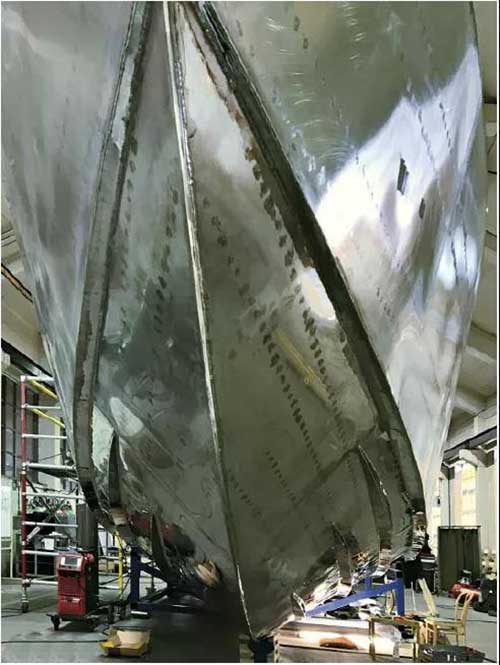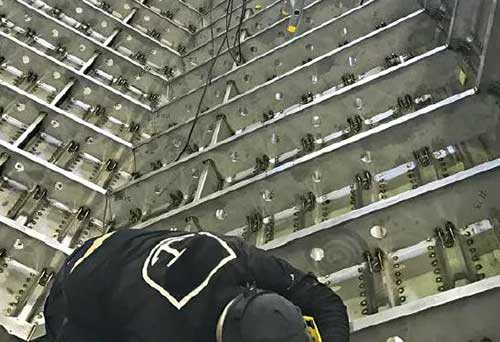Super stainless steel-build a new type of environmentally friendly ship(HY-industry technical centre)
Building high-performance ships requires sturdy materials. The traditional shipbuilding industry generally does not take stainless steel into consideration, but this situation is changing. In fact, governments and companies around the world have begun to take interest in a new, environmentally friendly and low-maintenance hull, which is made entirely of high-strength super stainless steel and super stainless steel without adding additional costs.
Depending on the size and purpose of the ship, the most commonly used materials for ship construction are steel, aluminum or glass fiber reinforced plastic (FRP). Regardless of the material, the maintenance cost of a ship is usually very high, because the ship is always exposed to water and moisture, almost any material will be damaged over time. Steel ships are strong and durable, but steel is heavy and requires corrosion protection and extensive maintenance.
Although aluminum is light, it is very soft, prone to pits, and has serious fatigue cracking problems. Corrosion is also a problem. Carbon fiber reinforced plastic is very light, but it is expensive, it will break when it touches the rock, it may even cause fire, and it cannot be recycled after its service life. Therefore, the time is ripe to adopt better and more sustainable solutions.

Fight against biofouling
The most important design considerations for ship performance are the weight of the ship and the surface quality of the hull. Reducing weight can improve the ship’s flexibility, top speed and fuel consumption. If the hull surface is rough, the resistance in the water will be greater, which will slow down the ship’s speed and increase fuel consumption. In addition, barnacles, seaweeds and other marine organisms are easily attached to the surface of the hull immersed in seawater. This process is called “biological fouling”, which makes the surface of the ship rough and uneven, which brings greater resistance to navigation.
In order to minimize the adhesion of marine organisms, the hull below the waterline is usually treated with antiseptic coating. These coatings are not only toxic to target organisms, but also extremely toxic to general aquatic organisms. Even if the antimicrobial paint is used, it only slows down but cannot eliminate the attachment of marine organisms, and divers must still remove the attachment of organisms. Commercial ships may need to be cleaned up once a month. Since the antifouling paint itself loses its effectiveness over time, it must be reapplied at least every few years. The ship was towed out of the water during the painting and was unable to operate. Now, ships built with special stainless steel provide a better solution.
Lighter, faster and stronger
Engineers Peng Jinwen, Wang Gongfeng and Liu Gensong of Shanghai Jiangnan Shipyard have always dreamed of building a lighter, faster, and stronger all-stainless steel vessel, but it is not easy to achieve it. Traditional stainless steels such as 304 or 316 austenitic stainless steels have insufficient corrosion resistance in seawater; although the toughness is good, the strength is insufficient. When engineers at Shanghai HY Industry Co., Ltd found that super stainless steel and super super stainless steel have significantly superior performance, especially the perfect combination of high strength and excellent corrosion resistance, the idea of building a stainless steel boat began to emerge.
If stainless steel, which is three times stronger than traditional carbon steel materials, is used to build ships, the thickness of the hull can be greatly reduced, thereby reducing the weight of the entire ship. But the problem is that in normal ship design, no matter how strong the thin steel plate is, it is easy to bend under wave load.
In order to solve this problem, engineers studied the shipbuilding technology of the nautical Vikings more than a thousand years ago and their efficient, strong and flexible wooden hull, which ultimately came from this inspiration. A similar design method for stainless steel can make the hull structure strong and light, the ship can glide effortlessly in the water, is very fuel-efficient, and can withstand major impacts without cracks or structural damage.
Ductility and energy absorption properties of stainless steel give the hull a good ballistic performance, ensuring that it can absorb potential shocks without breaking. Because ships have enhanced bulletproof and explosion-proof capabilities, military and law enforcement agencies have shown interest in this.

Stainless steel hull of the prototype ship of the shipyard
The main driving factor for seawater corrosion-resistant ships to adopt high-grade stainless steel is its light weight, and another greater advantage is that the ship can resist severe seawater corrosion without any protective coating. The molybdenum content of the two stainless steel alloys used in the design exceeds 2% of 316 stainless steel. Incoloy 901 super steel contains more than 5% molybdenum, and Hastelloy C-276 super steel contains more than 15% molybdenum.
These two kinds of stainless steels have a high content of molybdenum, which greatly improves the corrosion resistance of stainless steel, making them very suitable for long-term use in seawater with high chloride ion content. This type of stainless steel has a successful application record in the field of hydraulic systems and instrumentation in offshore oil and gas exploration and tropical marine environments.
The longitudinal girder is spot welded to the hull, and the frame welded to the longitudinal girder does not directly contact the hull. The flexibility of the stringers enables the ship to absorb the impact of waves and prevent the hull from bending.
Efficient and environmentally friendly
High-strength stainless steel is also very helpful in improving the fuel efficiency of ships. The increase in material strength means that the weight of materials required is much less than that of traditional ships. For example, a high-speed stainless steel patrol ship with a length of 15-25 meters requires a stainless steel plate with a thickness of 2-3 mm, which is 1/3-1/5 of the thickness of steel used in traditional ships.
Overall, these brisk stainless steel boats are about 50% lighter than similar carbon steel boats. Surprisingly, they are also lighter than aluminum boats, and even lighter than carbon fiber reinforced plastics, which is generally considered the lightest material.
In addition, the mirror-polished surface of the hull minimizes drag and friction, while improving fuel efficiency and reducing emissions, resulting in faster speed and flexibility. Moreover, the performance of the ship will not deteriorate over time, because the hull is very smooth, and any marine organisms such as barnacles that reduce the performance of the ship are difficult to adhere to the surface of the hull, thus avoiding the removal of biological fouling by divers every month. There is no need to reapply toxic antifouling paint every 5-7 years, which can save a lot of operating costs. Ships not only have direct maintenance costs, they also do not generate any revenue when painted in ports or dry docks.
Since super stainless steel does not corrode, there is no need to repair or replace it. At the end of its service life, stainless steel can be completely recycled and reused. All these benefits enable the ship to save a lot of costs throughout its life cycle, and more importantly, it can significantly reduce emissions and eliminate the impact of fungicides on marine life.
Overcome welding problems
Welding thin-walled super stainless steel and super super stainless steel to obtain a strong and corrosion-resistant weld is part of the core strength of ship design. Shanghai Jiangnan Shipyard has cooperated with stainless steel manufacturers, welding suppliers and industrial gas companies to develop specialized welding technologies.
Facts have proved that the strength of these welds is equivalent to the strength of stainless steel sheets and stringers, and the team is satisfied with the consistency and quality of the results. Thanks to lightweight, optimized design and efficient welding technology, the cost of these stainless steel boats is similar to that of traditional aluminum, steel or composite boats. With the increase in output in the future, the price of stainless steel ships will be even lower than those of traditional materials.

Welding of ship’s internal structure

